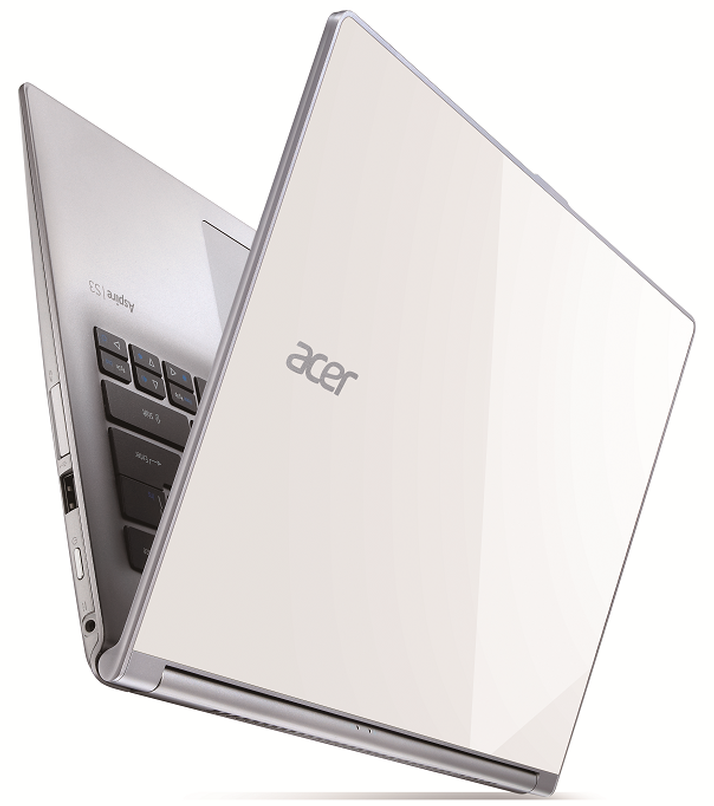This latest laptop is a little more expensive than some of its predecessors, but enhances performance with a hybrid disk/flashstorage drive and – unusually for an Ultrabook – it has a dedicated nVidia GPU. The brushed-metal aluminium design of previous models has been changed – probably to fend off the frequent comparisons with Apple’s MacBook Air – and the screen is now backed by the same distinctive white panel as Acer’s more expensive S7 range. This Aspire S3 looks very smart and stylish. It measures just 18 mm thick and weighs 1.65 kg, so it’s easy to carry around when you’re on the move. Acer pays good attention to detail too, with features such as the ‘wobble-free’ hinge that holds the screen firmly in position as you adjust the viewing angle. You won’t need to do that very often, though, as the 13.3-inch IPS panel is bright and colourful and provides excellent all-round viewing angles. The screen is touch-sensitive and we were also pleased to see that the low 1366 x 768 resolution of last year’s model has now been updated to full-HD’s 1920 x 1080. It’ll work very well for web browsing and streaming video, as well as business presentations or just browsing your photo library.
Acer Aspire S3 review: audio
The speakers were also a pleasant surprise – the bass, inevitably, could be a little stronger, but the S3 produced a firm sound with enough volume that we had to turn it down on occasion as it was too loud for use in our office. The keyboard may not suit everyone, though. The key pitch – the distance between the centre points of adjacent keys – is a standard 19mm, but the top row of Function keys is missing altogether. This means that some keys – such as the Esc key – have been squeezed onto other rows, which results in the left-hand Caps Lock and Shift keys being unusually small. It gives the keyboard a rather cramped feel, and isn’t helped by the way that other functions, such as the Mute and Wi-Fi controls, are scattered to unfamiliar locations around the rest of the keyboard. We were also disappointed to see that the S3 doesn’t include any ethernet port. Instead it relies on Acer’s proprietary Convertor Port, which requires a £20 adaptor in order to get fully wired. This latest model appears to be available in just a single configuration at the moment, priced at £900 with a Haswell-generation Intel Core i5 processor running at 1.6 GHz, 4 GB of memory and 500 GB solid-state hybrid drive (SSHD). The Seagate hard disk runs at the usual 5400 rpm, and is backed up by a 16 GB solid-state module that does a very effective job of boosting performance. As a result, the Aspire S3 scored a respectable 4282 points when running the general-purpose PCMark 7 benchtest. That will be more than adequate for most routine computing tasks, such as web browsing or running Microsoft Office. The increased performance of the SSHD was noticeable in other areas too, as the S3 woke from sleep in just a couple of seconds and only took 10 seconds to boot into the Start screen, when using the default Windows 8 ‘fast start’ option.
Acer Aspire S3 review: graphics performance
Graphics performance is above average for an Ultrabook too, as the S3 includes an nVidia GeForce GT 735M with 1 GB of video memory. That’s in addition to its integrated Intel HD Graphics 4400. The nVidia graphics allowed the S3 to hit a playable 34.5 fps when running our Stalker test at 1920 x 1080-pixel resolution. Dropping down to 1280 x 720 let that increase to a decent 62 fps. It’s no gaming rig, but the S3 will be able to handle some casual gaming action every now and then. The only real disappointment was the S3’s relatively short battery life. It did manage 5 hours (300 minutes) of streaming video, and less intensive use should allow it to reach to Acer’s quoted maximum of 6.5 hours. To be fair, that sort of performance would have been impressive a year ago, but it now falls conspicuously short of the 12 hours and longer offered by the best Haswell-based laptops. See also: What’s the best laptop you can buy?


